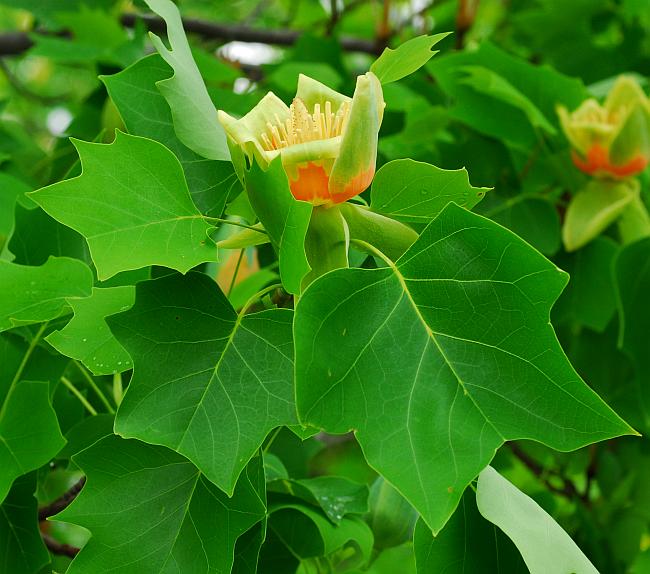Liriodendron tulipifera L.
Tulip Tree

Native
CC = 7
CW = 3
MOC = 24
© SRTurner
Liriodendron tulipifera L.Tulip Tree | |
 |
Native CC = 7 CW = 3 MOC = 24 |
© SRTurner |
|
Family - Magnoliaceae Habit - Tree to 40 m. Stems - Bark smooth on younger trees, becoming deeply furrowed with age, gray to dark gray. Twigs reddish brown to brown, glabrous, sometimes somewhat glaucous, the terminal buds somewhat flattened, rounded at the tip, with a characteristic "duck-bill" shape. Leaves - Alternate, simple, long-petiolate. Leaf blades 6-15 cm long, about as wide as long, nearly square in outline, 4-or 6-lobed, the tip appearing broadly and shallowly V-shaped, the base truncate to shallowly cordate, the margins otherwise entire or with a few additional points or small lobes on each side, the surfaces glabrous, the upper surface dark green to yellowish green, somewhat shiny, the undersurface pale green.
Flowers - Flowers with the perianth 3.5-6.0 cm long, consisting of 9 tepals, the outermost 3 sepal-like, spreading to reflexed at maturity, green, the inner 6 petal-like, ascending, greenish yellow with an orange base. Pistils numerous, free, hairy, densely packed around the elongated receptacle, each with 1 carpel, the ovary superior and with 1 or 2 ovules, the style and stigma 1.
Fruits - Fruits 3.0-4.5 cm long, narrowly oblong-ovate in outline, dense aggregates of tightly overlapping indehiscent sImage Flowering - May - June. Habitat - Mesic upland forests, mostly in ravines, and bases of bluffs. Extensively cultivated and often escaping. Origin - Native to the U.S. Lookalikes - None. Other info. - This majestic shade tree is found natively in far southern counties of Missouri, and is widely cultivated elsewhere. The flowers are large and slightly fragrant, and the trees are fast-growing and well suited for landscaping. The species is common throughout the eastern third of the continental U.S. Recognition is easy even when not flowering. The leaves have a distinctive shape, with a broad, shallow V-shaped terminus appearing as if cut off. This shape is unique and sufficient for a confident ID. Photographs taken near Labadie, Franklin County, MO, 5-17-2013 (SRTurner). |